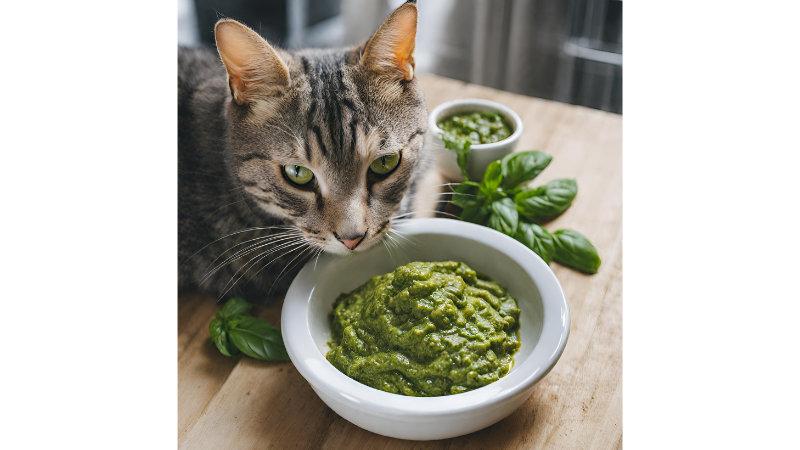Yes, cats can eat pesto, but it should be given in small quantities and only occasionally due to its high fat content. Pesto is a delicious Italian sauce made primarily from basil, garlic, pine nuts, olive oil, and parmesan cheese.
While it is safe for cats to consume these ingredients in small amounts, it’s important to remember that cats have specific dietary needs. Feeding your cat too much pesto can lead to digestive issues such as upset stomach or diarrhea, and the high fat content can contribute to weight gain and obesity.
Additionally, some cats may be allergic to certain components of pesto, such as garlic or onions. It is best to offer cats a well-balanced, species-appropriate diet and consult with a veterinarian before introducing any new foods, including pesto, to their diet.
Understanding Pesto
When it comes to adding flavor to our meals, pesto is a popular choice. This delicious sauce originates from Italy and is typically made from fresh basil leaves, pine nuts, garlic, Parmesan cheese, and olive oil. Its rich, aromatic taste can instantly elevate pasta dishes, sandwiches, or even be used as a dipping sauce. However, before you decide to share a taste of pesto with your feline friend, it’s important to understand the potential risks it may pose to their health.
Ingredients Of Pesto
Before we delve into the potential dangers of pesto for cats, let’s break down its main ingredients:
| Ingredient | Role |
|---|---|
| Basil Leaves | Aromatic herb that adds flavor |
| Pine Nuts | Provide texture and nutty taste |
| Garlic | Adds pungent and savory notes |
| Parmesan Cheese | Brings a creamy and cheesy flavor |
| Olive Oil | Acts as a binder and adds richness |
As you can see, these ingredients are perfectly safe for human consumption and can enhance our meals. But when it comes to cats, their digestive systems may react differently.
Potential Dangers Of Pesto For Cats
While some cats may be attracted to the smell and taste of pesto, there are potential dangers to consider:
- Garlic Content: Garlic, a common ingredient in pesto, contains compounds that can be toxic to cats in large quantities. These compounds may cause damage to their red blood cells, leading to anemia.
- Cheese: Although cats can tolerate small amounts of cheese, some cats are lactose intolerant. The Parmesan cheese in pesto may cause digestive upset or diarrhea in sensitive cats.
- Onions: In some cases, pesto may contain onions or onion powder, which are highly toxic to cats. Even a small amount can cause digestive issues, organ damage, or even worse.
It’s important to remember that cats have different dietary needs and metabolisms compared to humans. While you may enjoy pesto, it’s best to avoid sharing it with your furry friend to ensure their overall well-being.

Foods Cats Can Eat
Pesto is not recommended for cats due to its ingredients like garlic and onions, which can be toxic to them. Stick to cat-friendly foods to ensure their safety and wellbeing. Explore other options like lean meats or cooked vegetables instead.
Safe Foods For Cats
Cats are known for being picky eaters, but when it comes to their health, it’s important to know what foods they can safely enjoy. While many human foods are harmful to cats, there are several options that can be beneficial to their diet. As a responsible cat owner, it’s important to ensure that your feline friend is getting a balanced and nutritious diet. Let’s take a look at some safe foods that cats can eat.
Benefits Of A Balanced Diet For Cats
Just like humans, cats require a balanced diet to stay healthy and thrive. A well-rounded meal plan provides essential nutrients, vitamins, and minerals that support their overall well-being. A balanced diet can contribute to a shiny coat, strong teeth, and a healthy weight. When it comes to feeding your cat, it’s important to ensure that their nutritional needs are being met to prevent any deficiencies or health issues.
Now that we understand the importance of a balanced diet for cats, let’s explore some safe foods that can be beneficial for their health:
- Lean meats, such as chicken or turkey, can provide high-quality protein and essential amino acids that cats need for muscle development and maintenance.
- Fish, such as salmon or tuna, is a great source of omega-3 fatty acids, which can promote a healthy heart and reduce inflammation.
- Vegetables, like cooked carrots or peas, can provide vitamins and fiber that contribute to a healthy digestive system.
- Fruits, such as small amounts of sliced apples or bananas, can be a tasty and nutritious treat for cats.
- Plain yogurt can be given in moderation, as it contains probiotics that support a healthy gut.
It’s important to note that any new additions to your cat’s diet should be introduced slowly and in small quantities to prevent any digestive upset. Additionally, it’s crucial to avoid foods that are toxic to cats, such as garlic, onions, grapes, and chocolate. Always consult with your veterinarian before making any significant changes to your cat’s diet.
Can Cats Eat Pesto?
Cats are curious creatures and may show interest in the foods we consume, including pesto. However, it’s essential to consider the potential risks before sharing this popular pasta sauce with your feline friend. Pesto contains several ingredients that might not be safe for cats, such as garlic and onions.

Risks Of Cats Consuming Pesto
Pesto commonly contains garlic and onions, both of which belong to the Allium family. These ingredients can be toxic to cats, leading to a condition called Allium poisoning. The presence of compounds like thiosulfates in garlic and onions can damage a cat’s red blood cells, causing a condition known as Heinz body anemia. This can result in weakness, lethargy, and even organ failure.
Additionally, some variations of pesto may contain other harmful ingredients for cats, such as nuts, cheese, and overpowering herbs like basil or oregano, which might cause gastrointestinal upset or allergic reactions.
Symptoms Of Pesto Toxicity In Cats
If your cat accidentally consumes pesto or any dish that contains garlic or onions, be vigilant for any potential signs of toxicity. The symptoms might include:
- Vomiting and/or diarrhea
- Loss of appetite
- Lethargy and weakness
- Panting and rapid breathing
- Discolored urine
Should you notice any of these symptoms, it is crucial to seek immediate veterinary care for your cat. Early intervention can make a significant difference in their prognosis and recovery.
In summary, while cats might express interest in pesto, it’s best to avoid sharing this food with them due to the potential risks it poses. Instead, stick to a well-balanced and veterinarian-approved diet specifically formulated for your feline companion, ensuring their health and happiness.
Alternatives To Pesto
If you’re wondering if cats can eat pesto, the answer is no. Basil, a key ingredient in pesto sauce, is toxic to cats and can cause serious health issues. But that doesn’t mean you can’t share some delicious treats with your furry friend. Luckily, there are several cat-friendly alternatives to pesto that you can prepare easily and safely.
Cat-friendly Herbs And Spices
While basil may be off-limits, there are other herbs and spices that cats can enjoy in moderation. These herbs not only add flavor to your cat’s food but also offer various health benefits. Here are a few cat-friendly herbs and spices:
- Catnip: Catnip is a well-known herb loved by most felines. It can be sprinkled on your cat’s food or used in homemade treats.
- Mint: Mint is another safe herb for cats. You can add fresh or dried mint leaves to your cat’s food or make mint-infused water for them to drink.
- Parsley: Parsley is not only safe for cats but also helps freshen their breath. Chopped parsley can be added to meals or used as a garnish.
- Thyme: Thyme is a fragrant herb that can be sprinkled on your cat’s food to enhance the flavor.
Remember, moderation is key when it comes to introducing new herbs and spices to your cat’s diet. Start with a small amount and observe how your cat reacts before adding more.
Healthy Homemade Cat Treats
If you want to pamper your feline friend with homemade treats, there are plenty of cat-friendly options. Making treats at home ensures that you have full control over the ingredients and their quality. Here are a few ideas for healthy homemade cat treats:
- Tuna Treats: Mix canned tuna with a small amount of cooked egg and flour, then roll into small balls and bake until crispy.
- Chicken Chips: Thinly slice cooked chicken breast, then bake in the oven at a low temperature until they become crunchy.
- Sardine Delights: Mash canned sardines (without added salt or oil) and mix with a small amount of oat flour. Shape into small patties and bake until firm.
- Pumpkin Paws: Mix canned pumpkin puree with a small amount of flour and bake into bite-sized paw-shaped treats.
These homemade treats are not only safe for cats but also provide a healthy alternative to store-bought options, which may contain additives that are harmful to feline health. Always remember to consult with your veterinarian before introducing any new food or treats to your cat’s diet.
Frequently Asked Questions Of Can Cats Eat Pesto
Can Animals Eat Pesto?
Animals should not eat pesto as it contains ingredients like garlic and onions, which can be harmful to their health. Stick to their regular diet to ensure their well-being.
Are Pine Nuts Safe For Cats?
Yes, pine nuts are safe for cats. However, they should only be given in moderation as a treat.
What Do I Do If My Cat Eats Garlic?
If your cat eats garlic, immediately contact your veterinarian for guidance. Garlic is toxic to cats and can lead to serious health issues. Prompt action and professional advice are crucial in ensuring your cat’s well-being.
What If Dog Eats Pesto?
If your dog eats pesto, it may cause mild stomach upset. Some ingredients like garlic and onion can be toxic to dogs. It’s best to contact a veterinarian for advice.
Conclusion
While pesto can be a delicious addition to your own meals, it’s important to remember that not all ingredients in pesto are safe for cats. Some ingredients, such as garlic and onions, can be toxic to cats and should be avoided.
It’s always best to consult with your veterinarian before introducing any new foods into your cat’s diet to ensure their safety and well-being.







